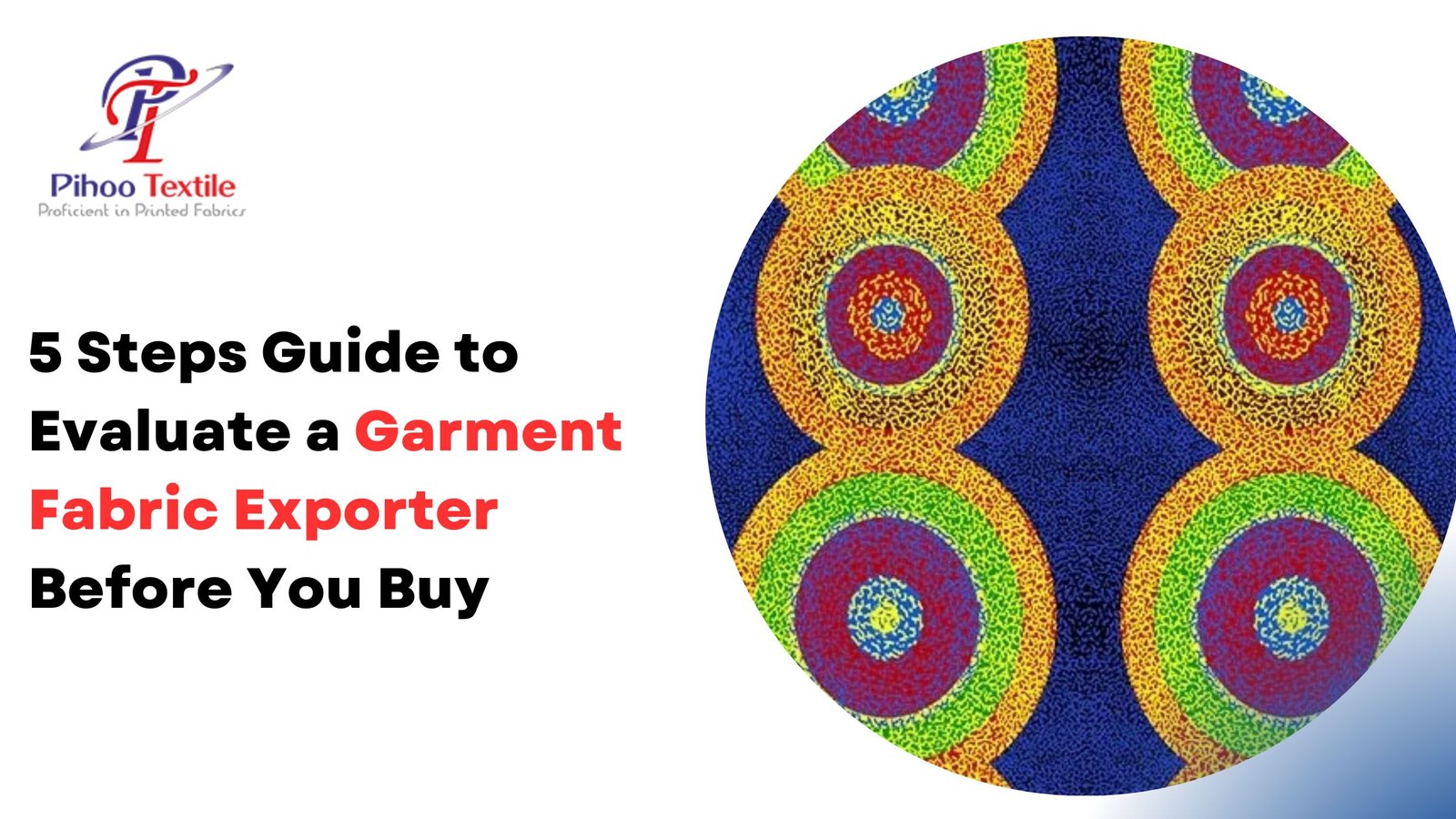5 Steps Guide to Evaluate a Garment Fabric Exporter Before You Buy
Imagine you’re about to launch your first clothing collection. You’ve designed stunning pieces, crafted a compelling brand story, and even lined up your first big orders. But here’s the catch: your entire venture hinges on the quality, reliability, and ethics of your fabric supplier. In the world of fashion startups, the fabric exporter you choose isn’t just a vendor—they’re your silent business partner, shaping everything from product quality and delivery timelines to your brand’s reputation and sustainability credentials.
This isn’t just about getting the right color or texture. It’s about ensuring that every meter of fabric meets your standards, that your supplier can scale with your ambitions, and that your supply chain is free of nasty surprises. As one industry insider puts it, “Choosing a fabric exporter is like choosing a business partner—pick wisely, and you’ll sleep soundly knowing your brand is in good hands.”
Consider this: nearly 40% of fashion startups cite supply chain issues as their biggest operational headache. But those who take the time to vet their fabric exporters thoroughly—well, they’re the ones who end up making headlines for all the right reasons. Ready to become one of them? Let’s break down the five essential steps to evaluating a garment fabric exporter—so you can buy with confidence and build a brand that lasts.
Step 1: Verify Supplier Credentials and Compliance
First impressions matter, but in the world of textile exports, credentials are everything. Before you even think about placing an order, dig deep into your supplier’s background. Are they registered with the right authorities? Do they have a proven track record of exporting to your target markets? And most importantly, are they compliant with international regulatory standards?
The best exporters don’t just meet the minimum requirements—they go above and beyond, often holding multiple certifications that signal their commitment to quality, safety, and ethical practices. “Certifications in the clothing manufacturing industry are credentials awarded by authorized bodies to validate a manufacturer’s adherence to specific standards, regulations, and best practices. These certifications cover a range of aspects, including product quality, environmental impact, worker conditions, sustainable sourcing, and more,” explains a leading industry guide.
Look for certifications like OEKO-TEX, GOTS, SEDEX, and ISO 9001. Each of these badges tells a story: OEKO-TEX ensures your fabrics are free from harmful chemicals, GOTS guarantees organic and sustainable production, SEDEX audits labor practices, and ISO 9001 signals a robust quality management system. “By adhering to such standards, manufacturers are equipped with the capability to differentiate themselves in a competitive market, enhance business reputation, gain customer trust, and fulfill the international expectation for transparency and responsibility,” notes a compliance expert.
Don’t just take their word for it—request documentation, check online reviews, and if possible, visit their facilities. A supplier who welcomes scrutiny is a supplier worth trusting.
Step 2: Assess Fabric Quality and Technical Specifications
Now it’s time to get hands-on. The most successful fashion entrepreneurs know that fabric quality isn’t just about how it looks—it’s about how it performs, feels, and endures. “Always order samples or swatch books to assess color, texture, weight, and finish before committing to a bulk order,” advises a fabric sourcing guru. “Perform quality tests: conduct wash tests, check for shrinkage, and evaluate how the fabric drapes. Look for certifications that ensure quality and sustainability.”
But don’t stop there. Dive into the technical specs: GSM (grams per square meter), fabric width, fiber content, and care instructions. Each of these details can make or break your final product. For example, a fabric that’s too light might not hold its shape, while one that’s too heavy could be uncomfortable to wear. And if you’re targeting eco-conscious consumers, certifications like GOTS or OEKO-TEX can be a game-changer.
One surprising truth: many startups skip this step, only to discover—too late—that their “premium” fabric shrinks, fades, or pills after a few washes. Don’t let that be you. Take the time to test, compare, and verify every detail before you commit.
Step 3: Evaluate Production Capabilities and Lead Times
Here’s where the rubber meets the road. Your fabric supplier might have the best credentials and the softest samples, but if they can’t deliver on time or scale with your growth, you’re setting yourself up for disaster.
Production capacity is a critical factor in the garment industry. “Production capacity in any manufacturing industry is the number of pieces the employees can manufacture in a given period of time, simply like an hour, day, or week. When it comes to the garment industry, production capacity is considered one of the prominent factors used by buyers for selection,” explains a textile consultant. “It is important that the marketing as well as planning department must be aware about the production capacity of the production lines.”
Ask your supplier about their daily or weekly output, their ability to handle multiple styles, and their lead times for both samples and bulk orders. A supplier who can’t meet your deadlines—or who struggles to scale up during peak seasons—can derail your entire business.
But here’s a zinger: many exporters overpromise and underdeliver. The smartest entrepreneurs ask for references, visit factories (if possible), and even run small trial orders to test their supplier’s reliability. “Strong supplier relationships make a huge difference in fabric sourcing. Cultivating trust and communication with your suppliers can ensure smoother transactions and help you get better terms, pricing, or access to exclusive fabrics,” says a retail strategist.
Step 4: Check Quality Control Processes and Certifications
Quality control isn’t just about catching defects—it’s about building a brand that customers trust. The best exporters have rigorous quality control systems in place, from raw material inspection to final product testing. They don’t just hope for the best; they plan for the worst, ensuring that every batch meets their exacting standards.
“Good garment exporters will always focus on keeping their end consumers happy. Meanwhile, they will ensure they do not compromise on the quality,” observes a leading industry blog. “All clothing manufacturers need to ensure they provide top-quality garments to garment exporters. They must take precautions and use materials that are suitable to the human skin in general. On the other hand, garment exporters must make sure they carry out inspections.”
Look for suppliers who conduct regular quality checks, use certified testing labs, and provide detailed inspection reports. Certifications like ISO 9001 or OEKO-TEX are a good sign, but don’t stop there. Ask about their process for handling defects, their policy on returns, and their commitment to continuous improvement.
One real-world insight: many of the most successful brands—think Pihoo Textiles—build long-term partnerships with their suppliers, working together to refine processes, improve quality, and innovate new materials. That’s the kind of collaboration that pays dividends for years to come.
Step 5: Review Customer Support and Communication Practices
Last but not least, consider how your supplier communicates and supports you throughout the buying process. The best exporters aren’t just order-takers—they’re problem-solvers, advisors, and partners in your success.
“Irrespective of the type of requirement, garment exporters must always be ready to cater to the demands of their clients. It is this characteristic that makes them readily available,” notes a reputable industry source. “For example, clothing manufacturers should be able to design prints and patterns that are famous outside Jaipur and also internationally, and be fully capable of serving clients that are located at different corners of the world.”
Look for suppliers who respond quickly to inquiries, provide clear and transparent pricing, and offer flexible payment terms. Ask about their policy on order changes, their process for handling delays, and their commitment to customer satisfaction.
Here’s a thought-provoking insight: the most successful fashion entrepreneurs treat their suppliers as extensions of their own team, building relationships based on trust, respect, and mutual benefit. When you find a supplier who truly understands your vision and supports your growth, you’ve found a partner for life.
Conclusion: Partnering with Confidence—How Pihoo Textiles Excels in Each Step?
Choosing the right garment fabric exporter isn’t just a checklist—it’s a strategic decision that shapes your brand’s future. By following these five steps—verifying credentials, assessing quality, evaluating production capabilities, checking quality control, and reviewing customer support—you can minimize risk, maximize value, and build a supply chain that supports your ambitions.
At Pihoo Textiles, we take each of these steps seriously. We hold multiple international certifications, conduct rigorous quality checks, and invest in cutting-edge production technology. But more than that, we pride ourselves on building partnerships based on trust, transparency, and shared success.
So, as you embark on your journey as a fashion entrepreneur, remember: the right fabric exporter isn’t just a supplier—they’re a cornerstone of your brand’s story. Choose wisely, and you’ll be well on your way to creating collections that inspire, delight, and endure.


